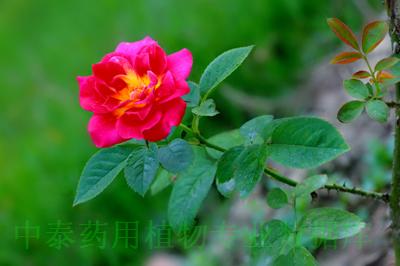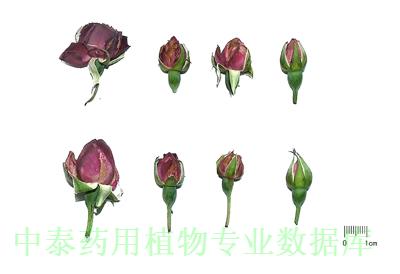| [English Name] | Chinese Rose Flower | |
| [Chinese Name] | 月季花 | |
| [Pinying Name] | Yuejihua | |
| [Latin Name] | Flos Rosae chinensis | |
| [Genera] | Rosaceae | |
| [Efficacy] | Blood circulation drug | |
| [Pictures] | Plant picture | Drug picture |

|

|
|
| [Alias] | ||
| [Source] | ||
| [Plant morphology] | ||
| [Distribution] | ||
| [Gathering and processing] | ||
| [Characteristics] | ||
| [Ecology] | It has strong adaptability,resistants to cold and drought,no strict damand of soil,but the slightly acid sandy soil with rich humus and good drainage is best.It prefers sunshine,but too much strong straight light is harmful to the development of buds, petals shrivel and wither easily,prefers wam,the temperature commly in the range of 22 to |
|
| [Chemical composition] | ||
| [Pharmacological activities] |
1. Antibacterial, anti-virus: Chinese rose of gallic acid in vitro antimicrobial effect of antibacterial concentrations is 5 mg/mL [1]. The flavonoids kaempferol it contains is a broad-spectrum antibiotics, quercitrin also has a strong antiviral activity [2]. 2. Antioxidant: Chinese rose extract has the effect of free radicals, the effect gradually increased with the increase in concentration of the extracts. Its clearance rate in proper sequence is 95% ethanol, water, 60% ethanol, ethyl acetate extract [3]. 3. Diuretic: Chinese rose contained quercitrin expansion of the renal artery, increase in renal blood flow and diuresis [4]. 4. Immune Enhancement: Chinese rose in the flavonoid constituents gate quercetin 0.01 ~ 0.001μg/ml within the concentration range can significantly promote the T-and B lymphocyte proliferation and enhances interleukin II (PGI2) production [5]. 5. Inhibition of platelet aggregation: Quercetin may activate platelet cyclooxygenase, enhance vascular endothelial coverage of platelet thrombosis at the PGI2 biosynthesis, inhibit the platelet aggregation, resulting in vasodilatory role against thrombosis and inhibit the platelet activation factors leading to platelet aggregation [6]. 6. For the treatment of cerebral thrombosis :Quercetin can reduce vascular permeability used in the treatment of cerebral thrombus, arterial sclerosis and myocardial infarction. 7. Anticancer:Quercetin has not only a variety of carcinogens, tumor promoters and mutagens antagonism, but also a variety of malignant cells such as Ehrlich solid tumor cells, Hela cells, human breast cancer cells human glioma cells, human pharyngeal cancer cells, a variety of cancer cells, colon cancer cells and ovarian cancer such as inhibition of growth [8]. 8. Protection of islet cell injury by exogenous nitric oxide (NO): Chinese rose water extract can reduce exogenous NO damage isolated rat pancreatic islet cells NO, malondialdehyde release, to improve the level of superoxide dismutase ,significantly improves the survival rate of cells, the insulin secretion quantity , restrains DNA content reduced .For esternal NO cause of islet cell damage ,it has a very good protection effect. |
|
| [Clinical trial] | 1. Intramuscular injection callosity: treatment group with Yuejihuafen, paste and apply to callosity place, 2 ~ 3 times per day, 1 h per time .The control group was treated by temperature towel hot compress, 2 ~ 3 timesper day, 1 h per time. Three days as one courses of treatment, the treatment for2 courses. Results: treatment group total effectiveness was 97.5%, the controlgroup total effectiveness was 75%, the curative effect of treatment group wasbetter than control group(P<0.01) [1]. 2. Diabetic gastroparesis: treatment group was treated by westernmedicine hypoglycemic therapy , on the basis of that, and was took Tangpikangcapsule ,three times per day, 4 capsules per time, take that in 30 minutesbefore meal. Control group was took moshabbethai the force treatment, three times per day, 10 mg per time, take thatin 30 minutes before meal. Two groups were treated all for 15 days, the treatmentgroup in 40 cases, 39 cases as control group. Results: the two groups aftertreatment gastrointestinal symptoms and fasting blood glucose, blood sugar 2 hpostprandial were significantly improved (P < 0.01), and the curative effectof treatment group was better than control group [2]. |
|
| [Properties] | ||
| [Medical and other Uses] | ||
| [Dosage] | ||
| [Cautions] | ||
| [Traditional usage] | ||
| [Toxicological studies] | ||
| [Pharmaceutical preparations] | ||
| [References] |
Chemical Composition: [1] State Administration Of Traditional Chinese Materia Medica Editorial Board."" Chinese Materia Medica. Shanghai: Shanghai Science And Technology Press,1999,10:216( Total2768). [2] Zhao Qian, Zhao Hongwu, Chen Weiping, Et Al. Studies On The Chemical Constituents Of Chinese Rose Flower (Ⅰ). The Ninth National Traditional Chinese Medicine And Natural Medicine Academic Conference Reports And Papers,2007,12:363. [3] Zhang Pei, Xue Ying, Green Linsen, Et Al. Studies On The Chemical Constituents Of Chinese Rose Flower. Chinese Herbal Medicine,2010,41(10):1616[4] Xu Wenzhao Rose Petal Flavonoids On.2000,16(4):225 Pharmacological Effect: [1] Huang Taikang. Handbook Of Common Chinese Medicine And Pharmacology . Beijing: China Medicine Science And Technology Press,1994 [2] Zhu Yutong, Yang Rucai, Su Zhang, Et Al. Non Volatile Oil Extract Houttuynia Cordata Antiviral Effect Of Chinese Herbal Medicine,1983,14(7):25 [3] Yingfen Hu, Hu Bolu, And So On. Rose Study On The Antioxidant Action Of Science And Technology Of Food Industry,2000,4(21):21 [4] Weng Weiliang, Fang Shuting . Clinical Pharmacy. Henan Science And Technology Press,1998 [5] Zhang Mei, Di Xiaohui, Liu Mei. Herba Ecliptae Flavonoids In Immune Regulation Effects Of Chinese Herbal Medicine,1997,28(10):615 [6]Grylewski RJ, Korbut R, Robak J, Et Al.On Themechanism Of Antithrombotic Action Of Flavonoids .Biochempharmacol,1987,36(3):317 [7] Zhang Yufen, Zhu Mingjuan. Effect Of Flavonoids On Inhibition Of Platelet Aggregation. Chinese Journal Of Cardiovascular Medicine,1995,3(5):391 [8] Mao Xueshi. Flavonoids Antitumor Activity. Foreign Med SCI,1995,22(3):93 [9] Liu Yingfa, Wang Xianming, Wang Minwei. Chinese Rose Flower Extract To Exogenous Nitric Oxide Damage Of Islet Cell Protective Effect. Journal Of Shenyang Pharmaceutical University,23(12):109 Clinical Trials: [1] Zhao Zhongju Rose Pollen Treated By External Application Of Intramuscular Injection Of Hard Day. Modern Medicine,2005,21(24):3494 [2] Lian Zhonge. Sugar Splenic Capsule Combined With Western Medicine In Treatment Of40 Cases Of Diabetic Gastroparesis. Jiangxi Journal Of Traditional Chinese Medicine,2006,37(5):38 |
|